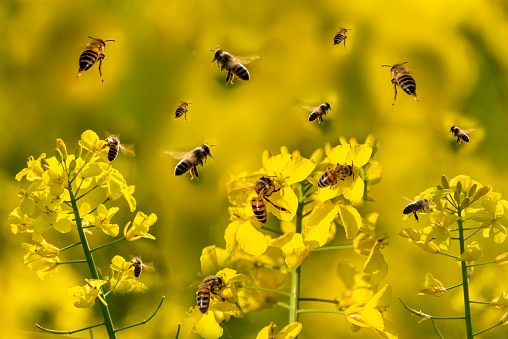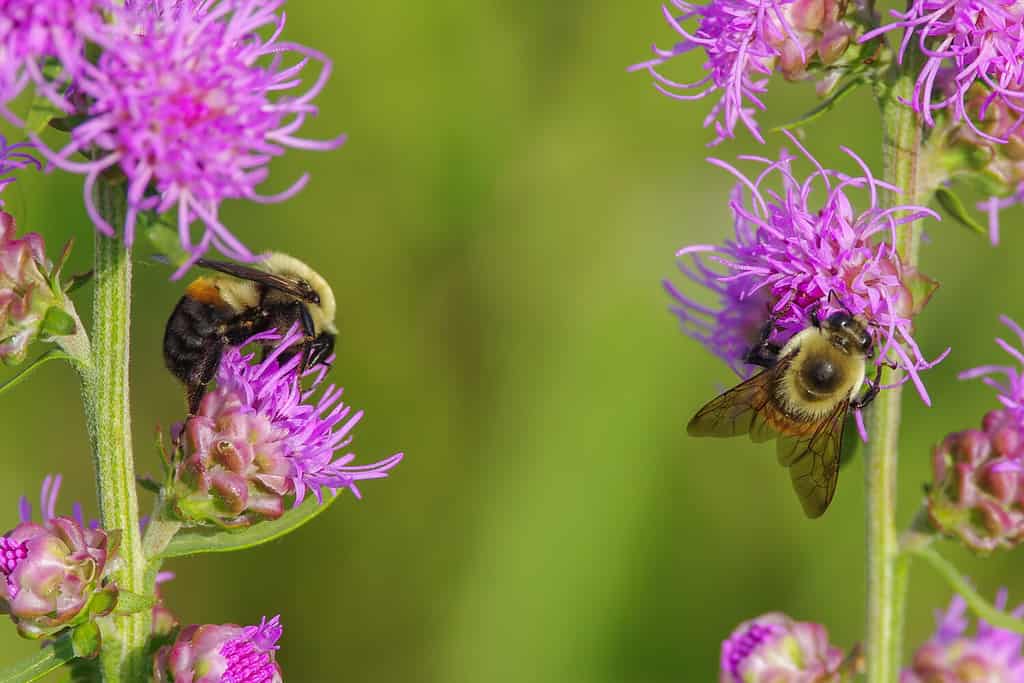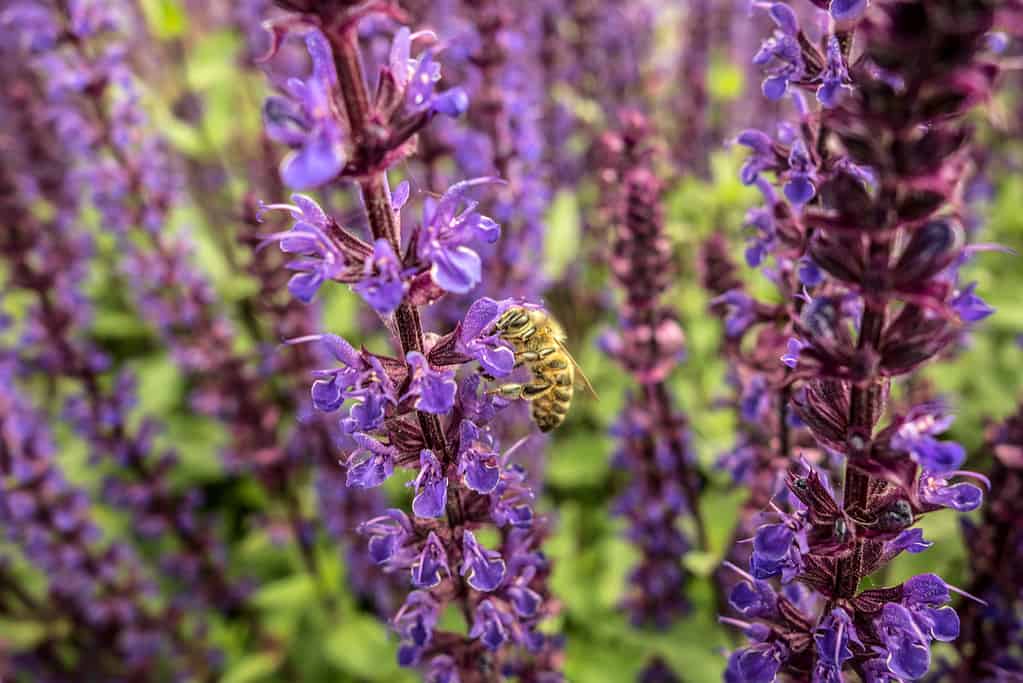
Bees, with their excellent vision, can only see approximately five colors.
©chris-mueller/iStock via Getty Images
Bees have great vision, but there are only a few primary colors that bees are attracted to. Although bees have excellent vision, they are only able to see colors in the shades of yellow, green, blue, violet, and ultraviolet.
Bees, similar to many other creatures, do not see the world the way humans do. Both humans and bees are trichromatic, meaning we both have three different photoreceptors in our eyes. These receptors can perceive different color spectrums, which assists in how color is differentiated. However, the photoreceptors for bees are better able to see colors like greens, blues, and ultraviolet colors.
Seeing as bees are crucial to our ecosystem, how and what they see determines their ability to pollinate. The ability to see ultraviolet colors makes a flower’s coloring pop to a bee. For example, the ultraviolet colors illuminate the petals, which guides bees to the nectar.
How Many Eyes Do Bees Have?
Of course, bees play an important role in pollination, and how they see color is impacted by how their eyes work. So, how many eyes do bees actually have and where are their eyes located?
Bees have five eyes in total. Two of these eyes are the bee’s primary eyes, which are located on each side of the bee’s head. The eyes are oval-shaped and assist the bee with seeing patterns and shapes. The bee’s main eyes, also called true eyes, are made up of multiple tiny lenses. Eyes with multiple lenses are called compound eyes.
In addition to having multiple lenses, the bee’s true eyes are covered in hair. Scientists assume that the hair might assist with wind navigation.
The other three eyes are simple eyes and are located on the top of the bee’s head. These eyes only sense light, which helps the bee always be apprised of where the sun is. The sun helps the bee navigate and having these three eyes on top of their head and attuned to the sun’s location, the bee is able to better assess its surroundings.
Having five eyes helps bees navigate the world more easily, assisting them with detecting a flower’s colors while constantly moving.
Colors That Attract Bees
Bees, unlike humans, do not have good visual acuity, so they are unable to see well from a distance. The lenses in their eyes allow them to focus up close. While there are five primary colors that attract bees, there are a number of other components that factor into a bee’s vision. For instance, flying enhances a bee’s ability to see.
Their color vision is one of the fastest in the animal world, and pairing that with the act of flying, allows them to see the three-dimensional world with depth and clarity. Here are the five colors that bees are most attracted to because of their ability to perceive the color.
1. Yellow

The color yellow is one of the few colors bees are able to see.
©Frank Wagner/iStock via Getty Images
Yellow is right on the periphery of colors that bees are able to see. As a result of the wavelengths of yellow and orange hues, bees are able to see the color yellow. Some yellow flowers that bees might be attracted to include goldenrods, black-eyed susans, sunflowers, marigolds, dandelions, and zinnias.
2. Green

Bees are able to see the color green, but it primarily depends on what the color is contrasted with.
©natmac stock/Shutterstock.com
Bees are also attracted to the color green. Scientists from the National Institutes of Health conducted a study in 2015 to determine how bees distinguish colors. Although bees can see the color green, it is often perceived based on how that color is contrasted with other colors. For instance, the study from NIH observed how bees interacted with particular colors, and if green had a blue hue or contrast, the bees were more likely to be drawn to that color.
While there aren’t many green flowers, the contrasting colors of flowers on top of their green stems could be within the bee’s range of vision, drawing them in.

Bees actually don’t prefer blue-colored plants.
©miroslavmisiura/iStock via Getty Images
3. Blue
The color blue is one of the easiest colors for bees to see, but blue-colored plants are actually less pollinated by bees. Similar to the color green, bees are more likely to see blended hues, such as blue purple. Some flowers in this color spectrum are ‘Princess Dark Lavender’ Verbena, Ever Sapphire Agapanthus, and Geranium ‘Johnson’s Blue.

Blooming violet lavender is one of the bee’s favorite flowers.
©ivanoel28/iStock via Getty Images
4. Violet
Violet shades tend to be the color that attracts bees the most. Austrian scientist Karl Von Frisch’s color test determined that bees are drawn to colors with UV rays, which tend to be bluer and violet-based hues. Frisch’s test involved multicolored cards, gauging which color the bee was most drawn to. The bees were deterred by red and orange colors, but they kept landing on the blue cards.
Bees can only see the light in wavelengths of 300 to 600 nanometers, and blues and violets fall within this range. Some violet-shade-colored plants and flowers might include allium, veronicas, and petunias.

Unlike humans, bees have no trouble seeing the ultraviolet color and X-rays.
©Byrdyak/iStock via Getty Images
5. Ultraviolet
The final color that bees are attracted to exists as a color and x-rays. Ultraviolet means “beyond violet,” and this coloring is most prominently associated with white because of how it mirrors light. For bees, ultraviolet might appear as a particular pattern to a bee. For example, the petals of daisies and sunflowers glow more brightly under UV light, which means they are more readily reproduced with the help of bees’ pollination.
While bees are attracted to certain colors, they also depend on flower shape and scent. And even though the colors above do attract bees, there are colors that repel bees—or at least keep them at a distance. Red hues are not easily discernible to bees because they appear black to them. Black is an absence of color, completely deterring bees. However, sometimes the color black might make bees think of an intruder.
The photo featured at the top of this post is © Alexandrum79/iStock via Getty Images
Thank you for reading! Have some feedback for us? Contact the AZ Animals editorial team.







